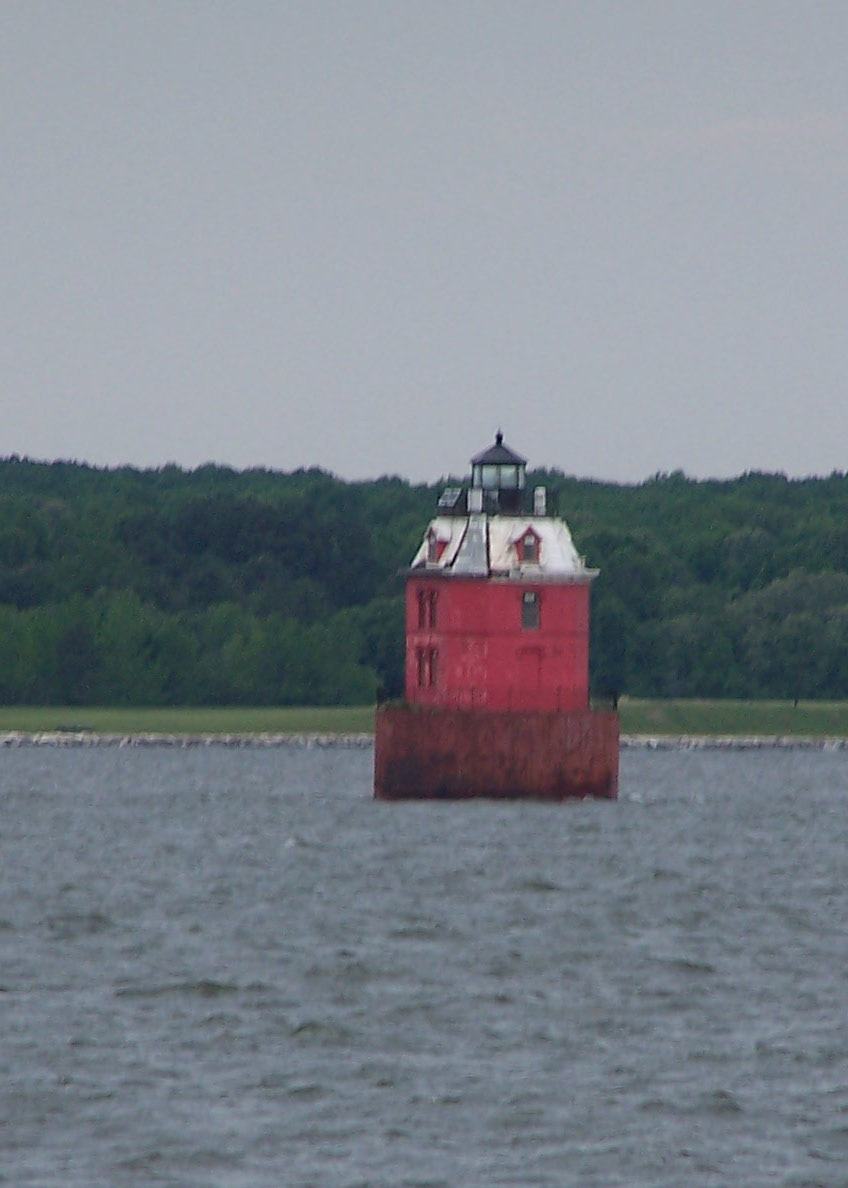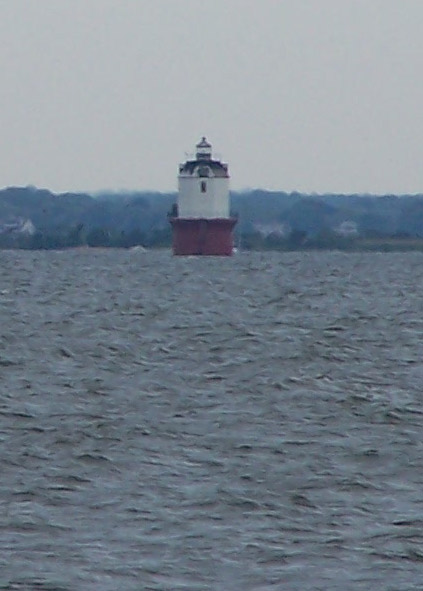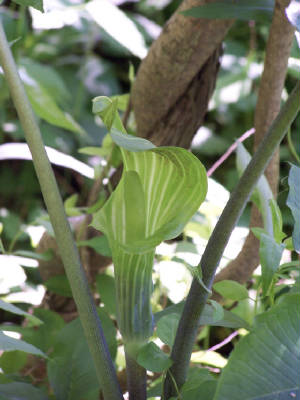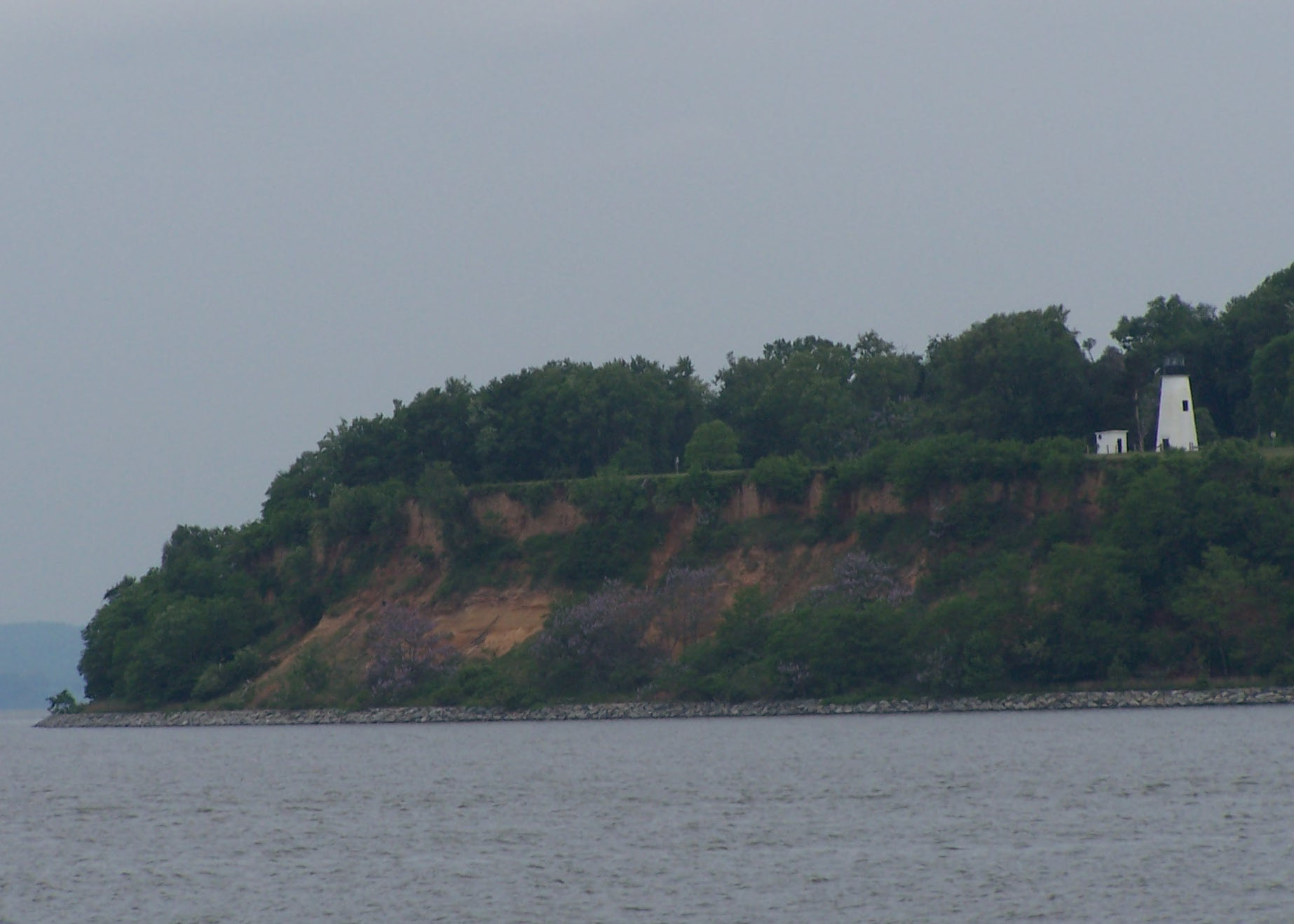|

|
| A stormy sunrise in Annapolis |
Sunday, May 22, 2005 Annapolis to Georgetown
51.3 miles
We were off our anchor ball and bidding farewell to Annapolis at a little after 7 on a rainy Sunday morning.
The weather this week is predicted to be very unsettled, with chances of showers and thunderstorms daily.
Because our extra time in Annapolis has put us behind schedule, and further weather delays are likely, we decided to get ourselves
north quickly. That way, we can be poised to cross Delaware Bay on a good day, and we won't miss getting to Cape
May in time to use our non-refundable Memorial Day weekend marina reservations.
The downside is we will miss visiting Baltimore, Rock Hall and Chestertown this trip.

|
| Sandy Point Shoal Light |
We've no time for regrets, and we' d best be on our way, so off we go in pretty stinky weather to Georgetown,
on the Sassafras River at the northwest end of the Chesapeake Bay.
We caught sight of two interesting historic lighthouses along the way. The first was Sandy Point Shoal
light, constructed in 1883 to replace a land-based light on the roof of a Victorian house. The light was electrified
in 1929, and fully automated in 1963. In 1979 the Coast Guard discovered that someone had smashed its handmade 19th
century cut crystal lens, and they replaced it with an acryllic one.

|
| Baltimore Light |
The Baltimore Light, located at the south entrance to the Baltimore Channel, took 13 years to build.
The bottom of the Bay where it is constructed has 55 feet of semi-fluid mud on top of solid sand. No contractor would
even bid on the job until the original budget was more than doubled. Then during construction, the structure was turned completely
over in a storm, and the contractor abandoned the job. Eventually, an insurance company took over the project, and funded
the effort to raise the structure from the bottom, but by then a lot of its parts had to be replaced due to damage from
the seawater.
The caisson goes 82 feet below the high water line, and was the largest caisson in the world when it was
built.
The Baltimore Light's other claim to fame is that it was the first nuclear powered lighthouse in the world.
In 1964 a small atomic reactor generator was installed in the house, but two years later it was removed.
Georgetown is eight miles up the scenic Sassafras River from the Bay. The river has high wooded
banks, punctuated with hillside estate homes whose impressive lawns slope down to the water. In some
spots where the bank has eroded away, homes sit atop golden clay cliffs.
There really isn't any town to speak of in Georgetown, but there are several marinas and lots of boats scooting
about on a Sunday afternoon. We thought about anchoring out, but decided to just hook on to an anchor ball from Georgetown
Marina instead.

We used the marina's complimentary bikes with big side baskets for a trip into Galena for groceries, with
a stop along the way at a park with a hidden geocache. We enjoyed a walk in the woods where there we lots of jack-in-the-pulpits
bigger than any we have seen previously -- knee-high.
Monday, May 23, 2005
Georgetown to Chesapeake City
27.7 miles
We left Georgetown under overcast skies with predictions of rain in the morning and showers and thunderstorms
in the afternoon. Our destination was Chesapeake City on the C&D Canal, a 35 foot deep commercial shipping canal
which connects the Chesapeake Bay with the Delaware River.
A classic lighthouse with an interesting history marks the entrance passage to the canal. The
light is built on Turkey Point, a 100 foot bluff, which makes it the tallest light on the Chesapeake, even though the lighthouse
tower is only 35 feet. It was built in 1833, when the C&D Canal was just four years old, and 10 feet deep.

|
| Turkey Point Light |
The Turkey Point Light has had more women lighthouse keepers than any other light on the bay. The
first two women replaced their husbands when they died -- the first served from 1844 until 1861 or 1862, and the
second served from 1873 until her death in 1895, when she was replaced by her daughter, who served until age 70.
The final keeper, Fannie Mae Salter, was the last woman lighthouse keeper in the United States. She
retired in 1947 at the age of 65, with 22 years of service as keeper, and 23 years previous assisting her husband. After
her retirement, the house was automated.
We were anchored in the basin in front of Chesapeake City by mid-morning, and had plenty of time to explore
the town, the C&D Canal Museum, and the woods outside of town where two geocaches were hidden. All
we needed was a break in the weather. And we got it.
We wore our raincoats into town, which guaranteed that the rain would stop, and it never really came
back all day.

|
| A colorful Chesapeake City home and garden |
Chesapeake City is quaint and colorful, with much of its original 19th century architecture intact.
The small saltbox houses built for canal workers are brightly painted in candy colors, and many have little gardens, window
boxes or front stoop container gardens. Several of the larger homes of prosperous business owners are now bed and breakfast
inns. The business district is vital and attractive, with a mix of antique and gift shops, art galleries, and restaurants.
There's even a General Store with its original 1861 glass cases and shelving.

|
| Shopkeeper Linda relaxing with Violet |
We visited the Chesapeake and Delaware Canal Museum, housed in the canal's original pumphouse. The
canal has no locks now, but in its early days there were two locks at Chesapeake City and two more in Delaware. Loss
of water from the canal, due to boats locking through and water leaking through the locks was a problem, so a steam engine
and 39-foot diameter waterwheel were installed at the pumphouse in Chesapeake City to lift water from a creek into the canal.
The wheel could lift over a million gallons of water per hour.
Today, 40 percent of all ship traffic in and out of the Port of Baltimore travels through the C&D Canal.
All ships engaging in foreign trade need to have a Coast Guard approved pilot aboard from the time they hit Delaware Bay to
the time they leave the Chesapeake (or vice versa). Pilots don't cross state lines, and Chesapeake City is near the
border between the states, so it is where the "changing of the pilots" takes place. The ship just keeps going while
a pilot boat comes alongside and the pilots hop on and off through the ship's port entrance. We were hoping to see a big ship
pass, but if there were any, we missed them. All we saw was a massive coal barge passing.
We hope not to see any big ships while we are again traveling in the narrow canal.
After our visit to the Museum, we struck out in search of geocaches. Our hunt took us to an unusual
area -- a high ridge with dirt roads terracing it at multiple levels going up. We wondered it the ridge had been
formed from spoil dredged when the canal was built. The top of the ridge had a large marshland area, some prairie,
and deciduous woods. It was a great spot for birding.
Even though the weather and time of day weren't the best for birding, we did see lots of birds, including
two we haven't seen before -- the Orchard Oriole and the White-eyed Vireo. We found both caches, too, bringing
our trip total to 85.
|

